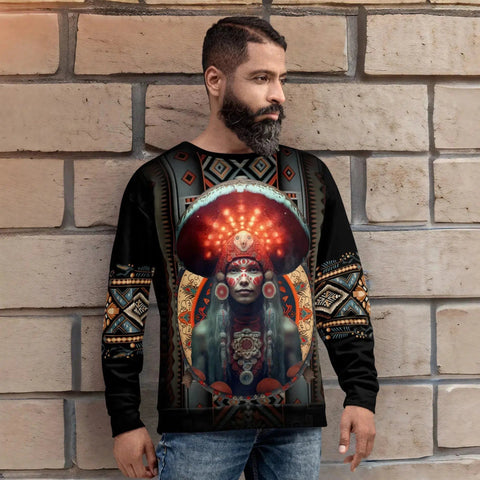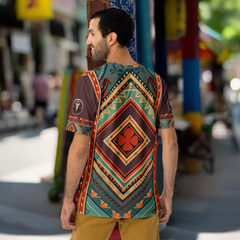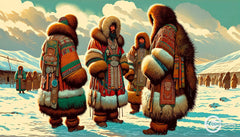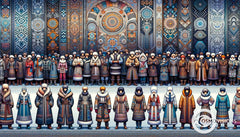The Rich Heritage Of Traditional Yakut Clothing: Exploring The Styles And Significance
Posted by Massimiliano Geraci
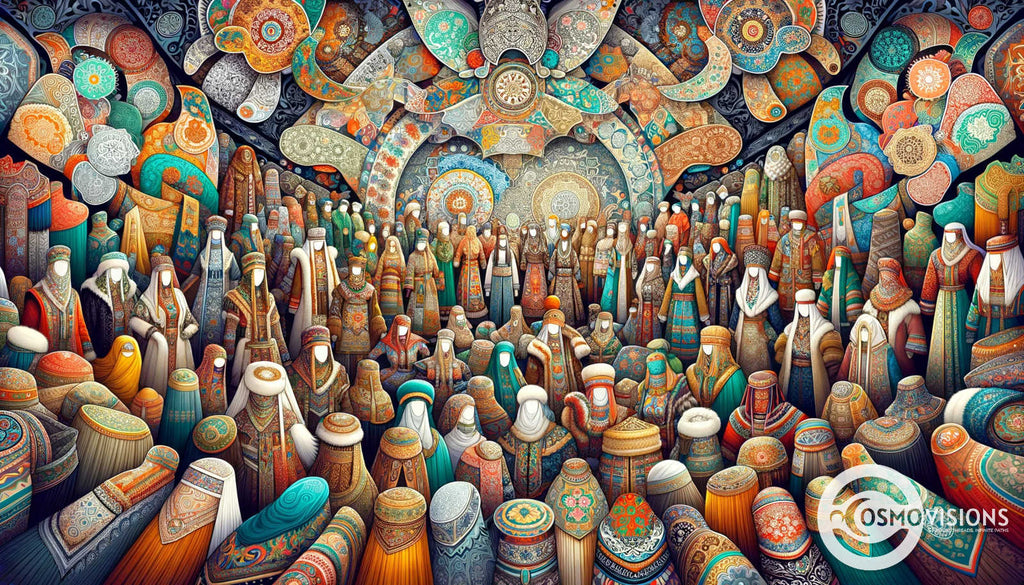
Nestled in the vast expanses of Russia lies a culture rich with history and tradition—the Yakut people. The search for cultural uniqueness often leads us to explore the diverse ways humans adapt to their surroundings, and clothing can speak volumes about this adaptation.
From enduring frigid winters to celebrating vibrant festivals, traditional Yakut attire is not just an ordinary aspect of life; it embodies the soul of an ancient community thriving against all odds.
One intriguing fact about Yakut clothing is its ability to protect natives from some of the coldest temperatures on Earth—often plunging below minus fifty degrees Celsius! As we unravel the story behind these unique garments, our blog will serve as your guide into understanding how style meets necessity, forming an integral part of identity for the Yakut people.
Together, we'll discover why each stitch is more than mere decoration; it's a testament to resilience and beauty molded by a harsh climate.
Ready for a journey into tradition? Let's delve deep into the world of Yakut dress.

The History and Culture of Yakut People
The Yakut people harbor a legacy that is deeply interwoven with the rugged tapestry of Siberia, their customs and language blossoming from ancient Turkic roots. This vibrant ethnic group has etched its identity onto the vast, icy tableau of the Sakha Republic, where traditions reflect a profound symbiosis with nature's mightiest elements.
Origin of Yakut people
Tracing the roots of the Yakut people reveals a rich mosaic of history, as their lineage emerges from a mix of local Siberian tribes and northern migrating Turkic tribes. These interactions birthed a unique ethnic group that adapted to one of Earth's most extreme environments.
They forged strong community ties and developed distinct cultural practices amidst the freezing landscape along the Lena River and beyond.
Yakuts honed survival techniques for generations, allowing them to thrive in harsh climates where winter temperatures plummet dramatically. Their storytelling, spiritual beliefs, and social structures reflect an intimate bond with nature—a connection deeply intertwined with their ancestry.
As we delve deeper into their world, we discover how language plays a crucial role in preserving Yakut heritage.
Yakut language
The Yakut language, a vital part of the Sakha Republic's cultural tapestry, boasts a rich heritage that mirrors its diverse linguistic neighborhood. This Turkic language diverged early from other Common Turkic languages and absorbed elements from neighboring Tungusic and Mongolian tongues, creating a unique dialect spoken by the indigenous Siberian peoples.
As one explores this distinctive language further, they unveil layers of historical interactions and exchanges that have shaped not only the speech but also the customs and traditions of the Yakut people.
Serving as a bridge between past and present, the Yakut language is more than just a means of communication; it encapsulates centuries of survival against seasonal extremes in some of Earth's coldest inhabited places.
Understanding its nuances offers insights into how these resilient communities have thrived through many centuries. Next up is an exploration into another cornerstone of Yakut culture – their faith and festivals – which equally enriches our understanding of this remarkable ethnic group's way of life.
Faith and festivals
Delving deeper into the cultural tapestry of the Yakut people, their spirituality and celebrations offer a vivid glimpse into their rich heritage. Faith deeply influences Yakut festivities, where rituals feature koumiss to honor seasonal changes.
Spring's awakening and fall's harvest are greeted with joyous festivals that showcase elaborately adorned traditional clothing—a testament to both reverence for deities and nature’s cycles.
These gatherings serve as more than mere festive occasions; they act as living museums displaying the Sakha people’s legacy. Visitors become witnesses to an intermingling of past and present, as locals don vibrant garments while engaging in age-old ceremonies.
Traditional garb embellished with glass beads and intricate embroidery becomes a spectacle against the backdrop of these spiritual events, inviting art lovers to appreciate an authentic slice of Yakutian culture.
Traditional Yakut Clothing
Delve into the realm of Traditional Yakut Clothing, where each stitch and pattern weaves a story of survival and identity in the harshest climates on Earth. This attire is not merely for protection against the cold; it serves as a canvas displaying the rich tapestry of Yakut heritage, meticulously crafted from indigenous materials that have safeguarded generations.
Materials used
The traditional Yakut clothing vividly illustrates the resourcefulness of this northern people, who turned the harsh environment to their advantage using materials at hand. With temperatures plummeting in one of the coldest places on earth, they relied heavily on animal-derived fabrics.
Luxurious furs and durable leathers formed the basis of their attire, providing crucial warmth and protection against fierce winters. These garments were not only practical but also paid homage to animals that played a central role in Yakut spirituality.
Craftsmen worked skillfully with fur, hide, leather, and suede to create pieces resilient enough for Siberian life yet imbued with significant cultural value. Soukno—a dense woolen fabric—alongside daba became staple textiles woven into daily wear and special ceremonial garb alike.
Each piece told a story; each stitch was an act of survival as much as it was an artistic expression. Moving forward from these sturdy foundations forged by their ancestors’ hands, we encounter the visual splendor and intricate craftsmanship defining classic women's yhyakh attire.
Classic women's yhyakh attire
Classic women's yhyakh attire showcases the exquisite craftsmanship and artistic heritage of Yakutian culture. This traditional outfit features an elegant djogdjuurdaax khaladaai, a distinctive garment that highlights the meticulous work and intricate details characteristic of Yakutan clothing.
Women wear garments similar to men’s but take them a step further with finer embellishments and an abundance of ornaments. These pieces are not just clothes but also symbols of identity, steeped in spiritual significance.
While men’s wear is about utilitarian robustness, women's dresses are canvases for displaying skill and creativity through detailed embroidery work. Every stitch speaks volumes about the wearer's status, with beauty intertwining with functionality to protect against harsh climates while still honoring cultural aesthetics.
Moving from this intricate tapestry woven by threads of tradition, we delve into another aspect—winter clothing—to understand how these remarkable people have adapted their material culture to survive the extreme cold.
Winter clothing and personal protective equipment
Moving from the vibrant yhyakh attire, Yakut winter clothing stands as a marvel of functional design and cultural heritage. In the biting cold of the Russian Far East, traditional fur coats transform into armor against harsh elements, showcasing detailed embroidery work that acts as both adornment and protective charm.
These garments are carefully crafted using sustainably sourced animal skins like sable and horsehide – materials proven to provide unparalleled warmth in Arctic conditions.
Personal protection extends beyond mere temperature regulation; boots with thick soles and gloves fashioned from soft yet sturdy leathers serve as essential gear for daily life amid snowdrifts.
Fur-lined hoods protect ears and heads while insulating layers safeguard the body's core heat. This indigenous innovation stems from ancient wisdom where every stitch holds meaning - connecting those who wear this apparel to their environment, ancestry, and spiritual beliefs.

Traditional Yakut Clothing: Significance and Symbolism
Discover the profound meanings woven into Yakut attire, where every stitch and pattern unveils a story of environmental harmony and communal identity—a tantalizing glimpse into a world where fabric narrates history.
Explore further to unravel these embroidered tales of tradition and spirituality.
Clothing as a reflection of the environment
Yakut clothing mirrors the harsh and beautiful landscape of the Sakha Republic, an area defined by its extreme temperatures and unique natural beauty. The people have mastered the art of survival in this environment, crafting garments from animal hides and furs that provide exceptional warmth.
These materials are not only functional but also sustainably sourced, respecting the balance between humans and nature.
Ornamentation on traditional attire tells a tale of reverence for both the earthly elements and spiritual beliefs. Intricate beadwork often represents ice crystals or the rays of a low-hanging sun—common sights in Yakut life.
Every stitch carries meaning, linking wearers back to their ancestors who first roamed these lands. Moving through time into present-day practices, Yakut clothing remains a conduit for cultural expression while embracing new influences and techniques.
Role of clothing in cultural and social events
Clothing functioned as more than just a means of protection against the elements for the Yakut people; it served as an essential cultural element, woven into the very fabric of their social identity.
During festivals like ysyakh, women adorn themselves in classic attire brimming with detailed embroidery work that tells stories of their heritage and faith. This traditional dress is not merely a garment but connects individuals to a lineage of ancestors and the spiritual realm.
It's common to see colorful fringe on garments or intricate jewelry incorporated into an outfit, each piece playing its part in warding off evil spirits and inviting favor from gods.
At weddings and other ceremonies, you'll witness clothing bursting with symbolism: every stitch and decoration carries meaning specific to ancient times while reflecting respect for traditions handed down through generations.
Men and women wearing fur-lined coats or ornate headdresses signal both status and connection to nature's bounty. Herein lies proof that for the Sakha language speakers, clothing transcends simple utility; it embodies pride in one's culture, showcases individual craftsmanship skills, and fortifies communal bonds during life's most significant moments.
Yakutian traditional cuisine
Yakutian traditional cuisine captures the essence of survival and adaptation in harsh climates. It showcases dishes such as stroganina, an ingenious creation borne from necessity, featuring frozen arctic river fish cut into long, delicate slices.
This dish is not merely sustenance but a celebration of the region's bountiful waters. Yakut chefs carve these thin shavings while preserving their fresh flavors, reflecting a deep respect for nature's offerings.
In this hearty fare you can also find kumis, a fermented dairy product made from mare’s milk, offering warmth and nutrition during biting cold winters. Every meal embodies the spirit of Yakut culture: resilient, resourceful and intimately tied to the land they cherish.
Moving beyond mere eating habits, these culinary practices serve as a gateway to understanding how deeply food weaves into their cultural tapestry.
Exploring Yakutian cuisine opens doors to appreciating more than just flavors—it invites us on a journey through history and spirituality woven into the very fabric of daily life.
The next portion delves further into how modern applications are weaving traditional attire with contemporary fashion trends.
Modern Applications of Traditional Yakut Clothing
As the allure of Yakut heritage captivates contemporary audiences, an exciting fusion emerges where ancient motifs meet modern fashion sensibilities. Today's Yakut clothing breathes new life into traditional designs, as innovative designers skillfully weave cultural narratives into wearable art that resonates globally, symbolizing a renaissance of ethnic identity through textile craftsmanship.
Yakut fashion designers
Yakut fashion designers weave the spirit of Siberia into their creations, telling stories through delicate embroidery and robust materials. They draw inspiration from a landscape as fierce as it is beautiful—birch bark whispers tales of survival while fur and ivory hint at a luxury that withstands harsh winters.
These artisans harness local legends, embedding them within their designs to transform traditional attire into modern masterpieces.
Their craftsmanship bridges ancient Yakutian heritage with contemporary demand, artfully reconstructing classic garments for today's world stage. With each stitch, they honor timeless practices yet push boundaries to redefine what wearing clothing means in both the Republic of Sakha (Yakutia) and global Fashion spheres.
Such dedication not only preserves cultural identity but also captures hearts across continents eager for fashion with soul.
Growing interest and appreciation for traditional Yakut clothing
As Yakut fashion designers capture the world’s attention, a broader wave of appreciation is swelling for traditional Yakut clothing. More and more people find themselves drawn to the unique styles that hold centuries of history and culture.
This fascination isn't just about aesthetics; it's about connecting with a rich heritage that speaks through detailed embroidery work and meaningful patterns.
The growing curiosity extends beyond the borders of the Russian Federation, reaching those who cherish anthropology, spirituality, and indigenous art. Enthusiasts from all corners are seeking out these garments for their intricate designs that tell stories of faith, festivals, and the daily lives of the Sakha people.
Each piece serves as a bridge between past traditions and modern expression—a living celebration of an enduring legacy not confined by time or place.
Technology and innovations in traditional clothing production
This growing fascination with Yakut attire has paved the way for technological advancements in its production. Modern methods now complement the historically labor-intensive processes, incorporating detailed embroidery work and innovative designs while preserving traditional values.
These innovations not only make these garments more accessible but also bring a fresh perspective to age-old styles.
Creators of traditional Yakut clothing are harnessing technology to tackle extreme Arctic conditions, balancing indigenous knowledge with contemporary science. The result is durable, functional wear that honors the past yet meets modern demands.
Techniques once used exclusively by Sakhas artisans are evolving, allowing for increased sustainability and ethical sourcing in line with today's ecological standards. Masters of the craft blend old-world charm with new world ingenuity, ensuring each piece from pantaloons to formalwear carries forward an enduring legacy.




